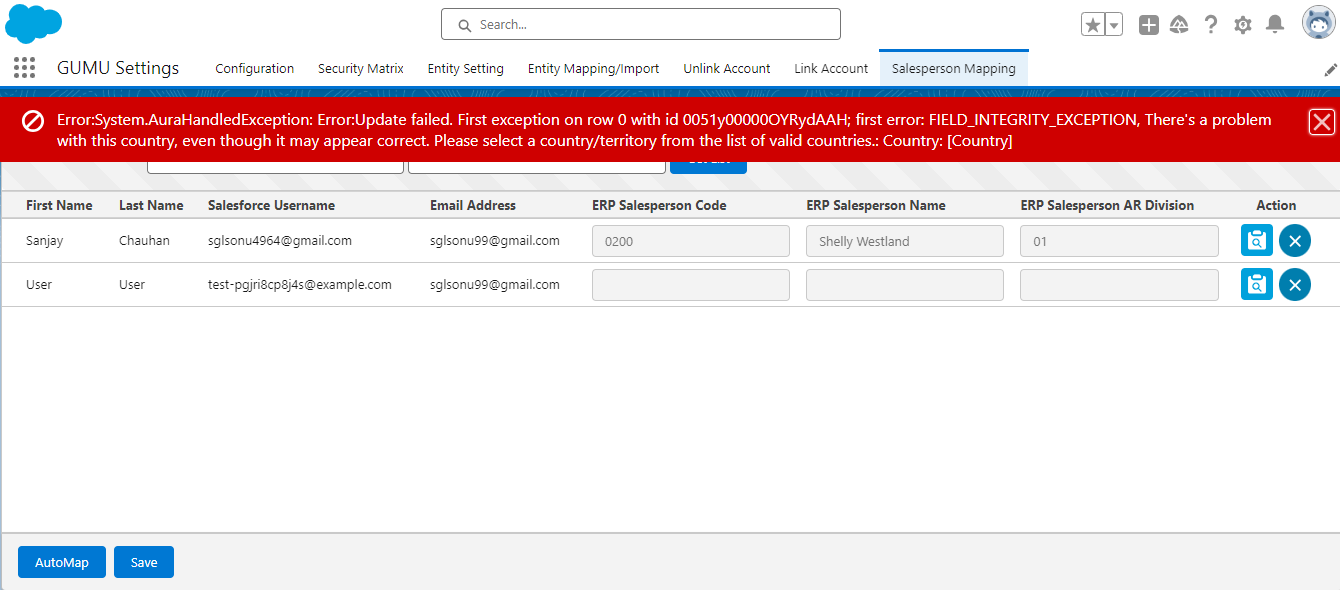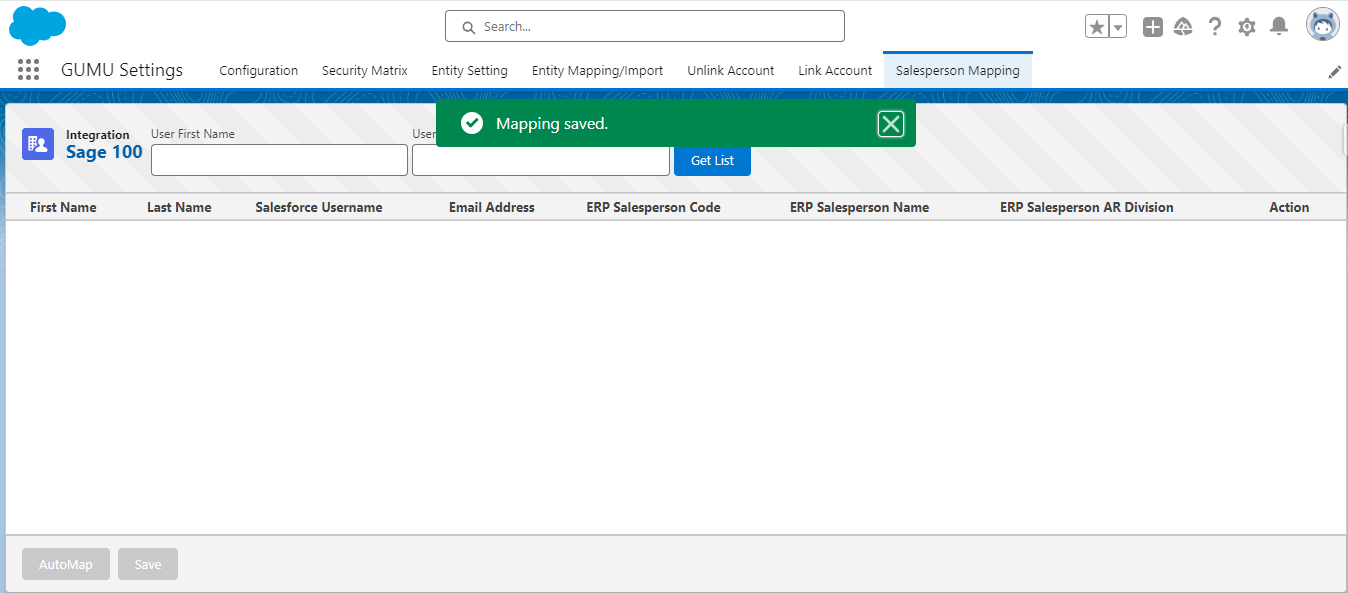Salesforce State and Country Territory Picklist feature helps keep data clean and offers faster and easier data entry. Salesforce on the other hand plays a crucial role in the management of customer relationships, and ensuring a smooth integration with ERP systems relies heavily on effective record ownership. However, the inclusion of the State and Country/Territory Picklist adds an extra layer of complexity, demanding careful attention and impacting certain integration functionality. In GUMU™, Salesperson Mapping is a vital functionality frequently utilized by organizations, linking Salesforce user details with the corresponding Salesperson in ERP.
Salesforce State and Country Territory Picklist
Scenario 1
In Salesforce, if a new User is created with Country and State values that are not valid, the system allows the record to be saved. Later, when the administrator enables the Salesforce State and Country Territory Picklist, the system prompts them to replace those incorrect values with valid options available in the picklist.
If the user opts not to replace them with particular values, they can choose “Unknown Value” from the list. However, if they later try to modify any data for a user, saving the record will not be possible, and an error message will be displayed as follows.

To resolve this problem, the user needs to either select a specific value from the list or eliminate the current value.
Scenario 2
The error message encountered when saving a Salesperson mapping record in GUMU™: “There’s a problem with this country, even though it may appear correct. Please select a country/territory from the list of valid countries.” Refer to the accompanying error image for more details.

When does the Error Occur?
Let’s explore scenario through an example:
When the Salesforce State and Country Territory Picklist is disabled, users have the flexibility to input data, such as using “CA” for the state and “US” for the country in the Name and Country fields for Salesforce. This information will be stored as text, and user mapping can proceed without encountering any errors.
However, if the Salesforce State and Country Territory Picklist is enabled, and a user tries to map a salesperson to an existing user with an address indicating “CA” for the state and “US” for the country, while the integration value for the United States in the Salesforce State and Country Territory Picklist is designated as “USA,” an error will be presented to the user, as illustrated in the above image.
Solution
After enabling the Salesforce State and Country Territory Picklist, it is essential for the user to update the address information associated with the specific user as well. Once the required adjustments to the address have been made, the user can proceed to reattempt the mapping process, which should now be completed successfully.

Conclusion
Salesforce State and Country Territory Picklist feature enhances data consistency and accuracy but introduces challenges during user mapping. Organizations must strike a balance between flexibility and validation, ensuring a smooth integration process. By following the best practices, providing user training, and implementing automated workflows, businesses can optimize Salesforce user mapping and enhance overall system reliability.
By following the above blog instructions, you will be able to learn details about Salesforce State and Country Territory Picklist and also “How to resolve the following error “There’s a problem with this country, even though it may appear correct. Please select a country/territory from the list of valid countries.: Country: [Country]“
More details about the Product are available on our website and Salesforce AppExchange.
We hope you may find this blog resourceful and helpful. However, if you still have concerns and need more help, please contact us at salesforce@greytrix.com.
About Us
Greytrix – a globally recognized and one of the oldest Sage Development Partner and a Salesforce Product development partner offers a wide variety of integration products and services to the end users as well as to the Partners and Sage PSG across the globe. We offer Consultation, Configuration, Training and support services in out-of-the-box functionality as well as customizations to incorporate custom business rules and functionalities that require apex code incorporation into the Salesforce platform.
Greytrix has some unique solutions for Cloud CRM such as Salesforce Sage integration for Sage X3, Sage 100 and Sage 300 (Sage Accpac). We also offer best-in-class Cloud CRM Salesforce customization and development services along with services such as Salesforce Data Migration, Integrated App development, Custom App development and Technical Support business partners and end users.
Salesforce Cloud CRM integration offered by Greytrix works with Lightning web components and supports standard opportunity workflow. Greytrix GUMU™ integration for Sage ERP – Salesforce is a 5-star rated app listed on Salesforce AppExchange.
The GUMU™ Cloud framework by Greytrix forms the backbone of cloud integrations that are managed in real-time for processing and execution of application programs at the click of a button.
For more information on our Salesforce products and services, contact us at salesforce@greytrix.com. We will be glad to assist you.
Related Posts
- Salesperson Mapping Functionality in GUMU™ for Salesforce – Sage X3 ERP Integration
- Salesperson Mapping functionality in GUMU™ with Sage 100 ERP – Part 3
- GUMU™ Features – Link Account By Exact Match With ERP Customer Record In GUMU™ Lightning Interface
- Using GUMU™ Link existing Salesforce Accounts with Sage 300 ERP Customers
- Salesperson Mapping functionality in GUMU™ with Sage 100 ERP – Part 2
- Unlinking Salesforce Accounts using GUMU™ lightning version

